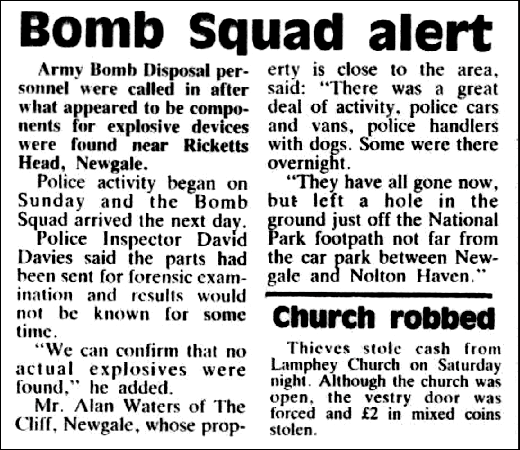Last week, a serving British soldier was arrested on suspected terrorist offences after police discovered quantities of arms and explosives hidden in both Northern Ireland and Devon.
This reminded Old Grumpy of the successful police operation just before Christmas 1989 which led to the arrest of two IRA members on the cliff path near Newgale as they attempted to recover a large cache of buried weapons.
Eighteen years later, in November 2007, the Western Telegraph carried an article which described the part played by the press in facilitating this coup.
This is what I wrote on 20 November 2007:
Last week’s Western Telegraph recalled the events of late 1989 when a police surveillance team arrested two members of an IRA gang who had returned to Newgale to recover a buried cache of explosives and other bomb making equipment.
The story was written by PCC spin doctor Len Mullins, who was the WT’s news editor at the time of the police operation.
“It was a blustery November afternoon 18 years ago when the news desk phone rang.” Len wrote. “We’d just put the paper ‘to bed’ and the reporters and sub-editors were beginning to unwind before preparing for the following week’s issue.”
“On the other end of the phone was Dai Davies, Dyfed Powys Police press officer. ‘Can you get up here pronto?’ he asked me. ‘We’ve got an important briefing, but I can’t tell you about it now.'”
An hour later Len and a score of other journalists found themselves at police HQ in Carmarthen.
“What we were told was shocking”, he says. “A huge arms cache had been been discovered just off the coast path at Rickets Head, Newgale. Anti-terrorist officers from the Met would be carrying out a 24-hour surveillance at the scene [Operation Pebble] and planned to catch the gun-runners red-handed.”
“Would the press agree to a news blackout and not blow Operation Pebble wide open?”
The press agreed to go along with this request and, Mr Mullins says: “Not a word of the arms cache discovery appeared in newsprint, on TV or over the radio.”
This cloak and dagger scheme worked a treat and seven weeks later, just four days before Christmas, two Irishmen turned up to recover the hidden cache and were promptly arrested by the waiting police.
They were later tried at the Old Bailey and given 30 years apiece.
Unfortunately, Mr Mullins’ account of the events of early November 1989 is not on all fours with the facts.
The police discovered the hidden arms on, appropriately, Sunday 5 November 1989.
Naturally, local people noticed all this activity and contacted the Western Telegraph which checked the story out with the police who confirmed the find.
 Thanks to Grumpette’s carefully filed library of old press cuttings, I am able to reproduce the following article which appeared on the front page of the WT dated 8 November 1989, some six weeks before the trap was sprung.
Thanks to Grumpette’s carefully filed library of old press cuttings, I am able to reproduce the following article which appeared on the front page of the WT dated 8 November 1989, some six weeks before the trap was sprung.
In fact, this was the paper that Mr Mullins had just ‘put to bed’ when he received the urgent phone call from police HQ.
That being the case, it is difficult to see how, having only a matter of hours earlier put the story on the front page, he could have found what the police had to tell him about the arms find ‘shocking’.
What actually happened was that the local police were initially keen to publicise their find, but, when the big hitters from Special Branch arrived on the scene and decided to run a covert surveillance operation, it was realised that publicity would be fatal.
So the urgent meeting on the Tuesday evening was not part of a carefully worked out strategy, but a damage limitation exercise designed to prevent the Telegraph’s front page story gaining wider currency.
Fortunately the IRA men concerned were not Telegraph readers and Operation Pebble turned out to be a brilliant success for the security services.
The WT can’t be criticised for running the original story which they had checked out with the police before publication.
However, rewriting history is another matter.
